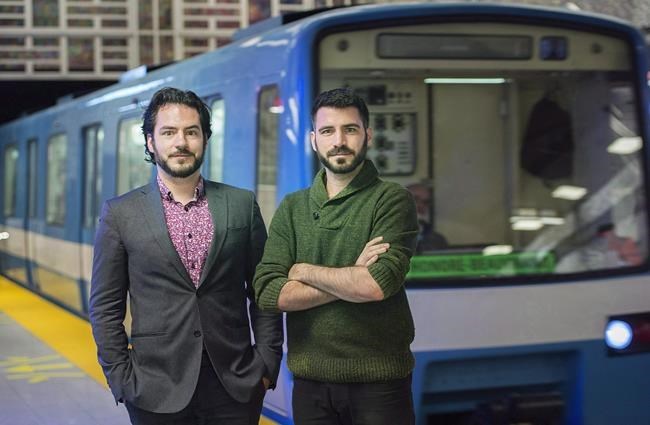
Frederic, left, and Etienne Morin-Bordeleau, co-founders of Project MR-63 pose next to a Montreal Metro, Saturday, October 14, 2016. As Montreal's original subway cars are being gradually pulled out of service, at least a few of the 50-year-old cars will be getting second lives. THE CANADIAN PRESS/Graham Hughes
October 23, 2018 - 8:53 AM
Montreal's original subway cars were taken off the tracks two years ago, but local entrepreneurs have unveiled a plan that would see the blue and white cars serving the city for another century.
Frederic Morin-Bordeleau, 30, and his brother Etienne revealed details Tuesday of a planned multi-level structure composed of the two-ton cars stacked inside an eco-friendly glass shell.
Frederic Morin-Bordeleau's vision is of a building that would serve as a concert hall and meeting space as well as a showcase for local creations, from micro-brewed beer to art and pop-up design shops.
"It should create a sense of pride, definitely, because it's unique in the world," he said in a phone interview.
The building, designed by the architectural firm Rayside Labossiere, would feature solar panels that make it carbon neutral and ensure as much energy is created as consumed.
"It's going to be mainly glass, so that's mainly what you'll see (from the outside)," Morin-Bordeleau said in a phone interview.
"But it's going to be a glass that will allow us to control the temperature and the humidity inside."
It's what will lie behind the glass that makes it an only-in-Montreal project.
Opened in the 1960s as the city prepared to stage the Expo 67 world fair, the metro has long been romanticized by city residents. Just this month, a sale of cast-off transit items, such as subway seats, doors and platform signs, drew hundreds of shoppers.
An architect's drawing of the project shows the Smurf-blue cars stacked three storeys high. At ground level, they form a U, creating a courtyard where people can sit beneath a blue wall of metro cars.
Tuesday's announcement is another step in a long process for the Morin-Bordeleau brothers, who began the project while in their mid-twenties with no previous design experience.
In 2016, Montreal's transit agency issued a call for proposals for members of the public who wanted to buy and transform the first-generation MR-63 cars, which were set to be gradually replaced.
To be approved to buy the cars at a price of either $750 or $1,000, plus shipping, applicants had to present a project that was environmentally friendly, included a plan for financing and honoured the cars’ legacy.
Morin-Bordeleau acknowledges that transforming their eight subway cars into a building has been "much harder" than he originally expected.
An initial concept, in which the stacked cars would have formed the building's exterior, was scrapped when it proved too difficult to winterize the cars without compromising their signature look.
The design finally chosen will cost a hefty $7 million to build.
"Working with a heritage component is something that we have to put a lot more effort and money into, to conserve the (subway) trains, so it costs a little more than another building of the size," he said.
But Morin-Bordeleau believes that the non-profit society he co-founded will be able to raise the necessary funds.
This summer, the group created a temporary public space out of four of the cars. Dubbed project FMR, the site's concept proved to be a success and raised the group's confidence, Morin-Bordeleau said.
The project is supported by the city government, and Bordeleau believes a combination of grants, sponsors, and public support will cover the rest.
The permanent structure is likely to be located in a park in the Griffintown neighbourhood south of downtown, where the group hopes to obtain a 99-year lease from the city.
He says it will likely break ground in 2020 with a grand opening a year later.
Morin-Bordeleau believes it's a fitting homage to the subway cars, which were themselves a model of ingenuity and design when they first began carrying Montrealers to their destinations in 1966.
"They were about to be thrown away and never really thanked," he said.
"By reusing them and keeping them, conserving them and giving them a new life, I think we're giving them some sort of a thank you."
News from © The Canadian Press, 2018